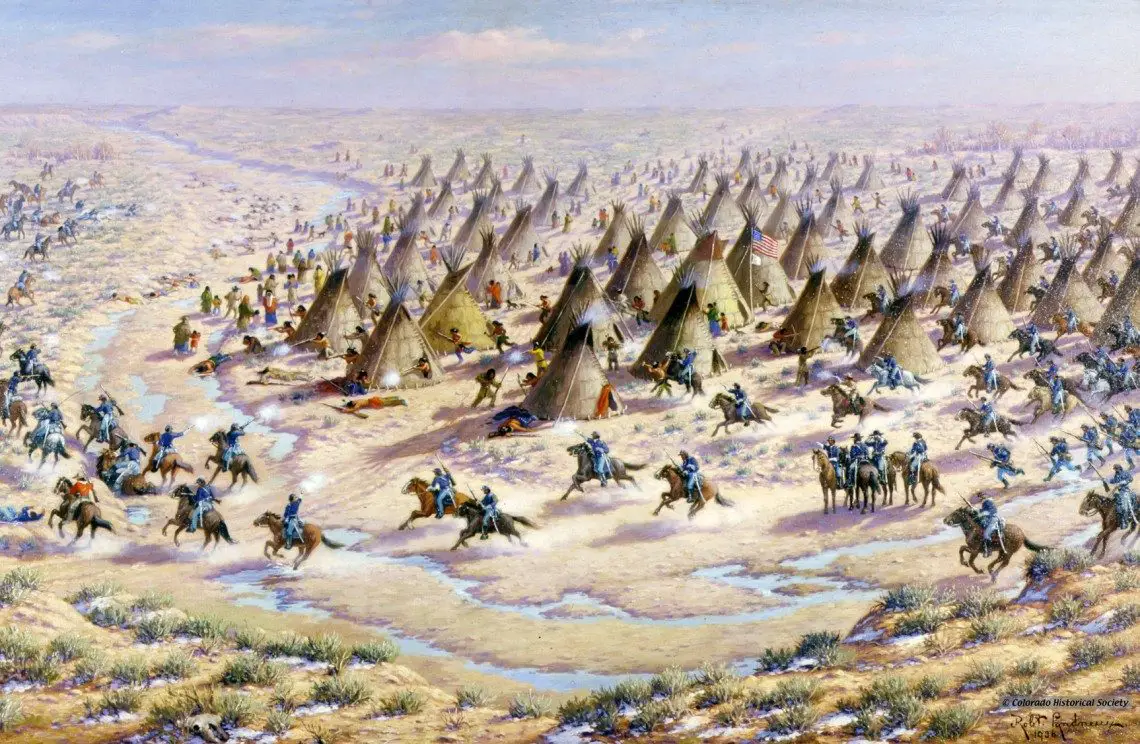The most recent mass shooting in America occurred on October 1, when gunman and domestic terrorist Stephen Paddock opened fire from the Mandalay Bay Hotel in Las Vegas, killing at least fifty-eight people and injuring hundreds more. Paddock’s act of terrorism was quickly labeled by major media outlets as the “worst mass shooting” in US history. Describing the particular act of violence as such continues to effectively ignore the continuous plight of people of color throughout American history as viewed from a Eurocentric perspective.
The recurrence of mass violence has become one of the defining aspects of American history in the last few centuries. The mass violence is prominently directed towards people of color after the arrival of Europeans, particularly Native Americans in the early years of European colonization and African Americans following their forced arrival into the Americas.
However, irrevocable reduction of the Native American population by way of disease is what is commonly taught in schools across the nation. But primarily focusing on death by disease effectively ignores the mass violence perpetrated by Europeans to gain power over people they deemed uncouth and primitive.
Incidents of violence against Native Americans are plenty, even after their populations were largely decimated. A prominent, yet not widely known example of mass violence directed towards natives is the Sand Creek Massacre. In 1864, six hundred and seventy-five men from the Colorado U.S. Volunteer Cavalry attacked with the intention of destroying a village of Cheyenne and Arapaho people in the southeastern Colorado Territory, which resulted in the killing of an estimated seventy to one hundred and sixty-three Native Americans, the majority of whom were women and children. Yet the Sand Creek Massacre, and other similar events of the past, is not known today as one of the worst mass murders in American history.
The Sand Creek Massacre was notable at the time through its wide condemnation by the US government and military. However, it occurred nearly two centuries ago, and the memory has inevitably receded in America’s collective consciousness. Though the Sand Creek Massacre, dubbed as the My Lai of its time, is not common knowledge among Americans today, it remains the only National Park Service site that contains the word “massacre” in its name.
Today, the site of the horrific killings is known as Sand Creek Massacre Historic Site. The prominence of the word “massacre,” as well as its designation as a National Historic Site, allows the memory of the tragedy to live on, as well as provide insight into the horrors endured by the natives and other victims as a result of European mass violence.
In the Americas, the population of Native Americans is inversely related to the population of Europeans. It has become common textbook knowledge that, since the inception of colonization, the native population has irreversibly dwindled by 90 percent. The exact population of natives before colonization is unknown, with scholars estimating anywhere from one hundred and twelve million to as low as eight million. However, though the exact magnitude of population decline and decimation of ancient cultures may never be known, it is undeniable that the population of natives directly suffered as a result of frequently unchecked mass violence.
Following the decimation of the majority of natives, mass violence continued to be directed to oppressed minority groups, particularly African Americans. Centuries of violence and systematic oppression faced by African Americans are also a defining aspect of American history. In American public schools, violence against African Americans is not taught directly, but rather more implicitly through discussions of slavery and the fight for civil rights legislation. Furthermore, discussions of violence against minority groups continue to be circumvented even today, with headlines dubbing today’s mass shootings as the “worst…in U.S. history.”
In 2016, domestic terrorist Omar Mateen shot and killed forty-nine people and wounded fifty-eight others at Pulse, a gay nightclub in Orlando. At the time, the media immediately dubbed the act of domestic terrorism the “deadliest mass shooting in U.S. history.” The impact of the declaration reverberated throughout the country and permanently solidified the impact of the Pulse nightclub shooting in history. At the time, there was little attention drawn to the impact of the common headline and its effect on minority populations past and present. However, since Pulse has been overtaken in death toll by Las Vegas, increasing awareness of continual erasure of minorities has been raised.
Mass shootings are a relatively recent phenomenon in American history, so it makes sense that they are at the forefront of the common consciousness, rather than incidents of violence that occurred hundreds of years ago and largely directed towards minority groups. However, the impact of the violence faced by minority groups, even in recent U.S. history, is too often forgotten.
According to the Equal Justice Initiative, lynchings of African Americans perpetrated by white communities in the South killed more than four thousand people between 1877 and 1950. However, the number is widely believed to be an underestimate, as the report only includes states in the Southern U.S. and there is possibility of underreporting or absence of reporting. Regardless of the exact number of African Americans lynched following the outlaw of slavery, the death toll is enormous and the magnitude of the lynchings is fit to be considered mass violence.
Describing the Las Vegas massacre as “the deadliest mass shooting in modern U.S. history” only further erases and white-washes the oppression faced by Native Americans, black Americans, and other oppressed minorities from the national conversation. However, discussion of minority oppression and historical mass violence is not meant to distract from current issues facing the U.S., particularly those of gun violence and lack of action from the federal government. Rather, it is important to consider the implications of recent events with those of the past in mind, to preserve the memory of historical events that directly affect the U.S. today.

















